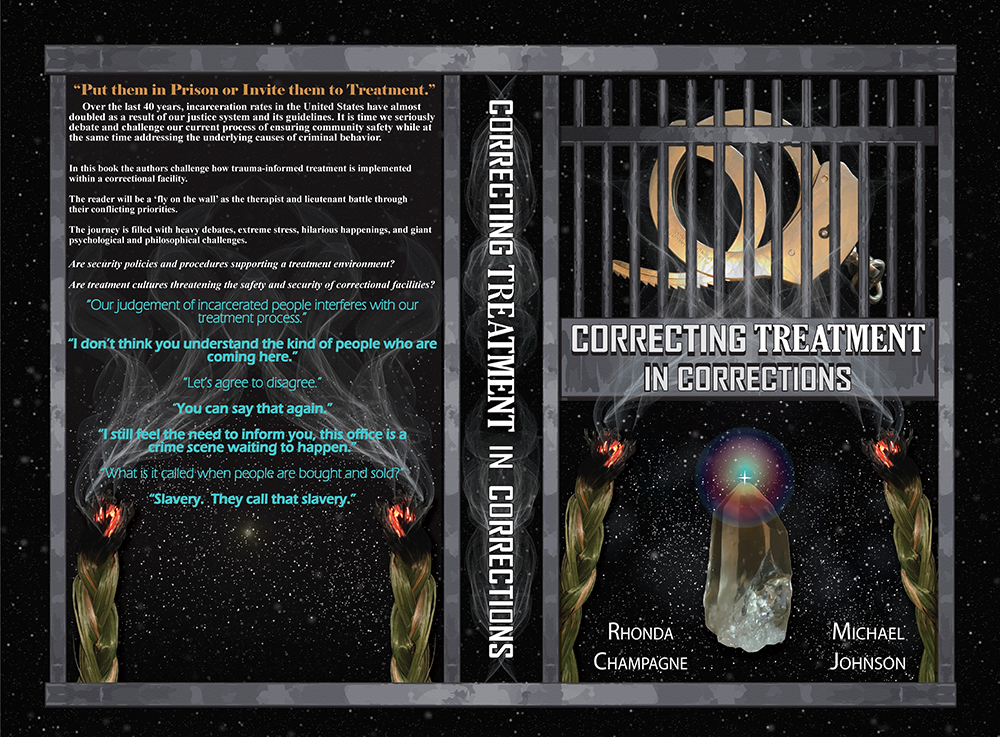Synopsis
“The United States is the world’s leader in incarceration with 2.2 million people currently in the nation’s prisons and jails, a 500 percent increase over the last forty years. Changes in sentencing law and policy, not changes in crime rates, explain most of this increase. These trends have resulted in prison overcrowding and fiscal burdens on states to accommodate a rapidly expanding penal system, despite increasing evidence that large scale incarceration is not an effective means of achieving public safety.”
Title: “CORRECTING TREATMENT IN CORRECTIONS”
Category: Narrative / Prescriptive Non-Fiction
Word Count: 40,000
Co-authored: Rhonda Champagne & Michael Johnson
Are security policies and procedures supporting a treatment environment?
Are treatment cultures threatening the safety and security of correctional facilities?
Over the last 40 years, incarceration rates in the United States have almost doubled as a result of our justice system and its guidelines. Research-based studies show a large population of incarcerated people have underlining trauma related to addiction and criminal behavior. It is time to seriously debate and challenge our current process of ensuring community safety while at the same time addressing the underlying causes of addictions and criminal behavior.
In the book “Correcting Treatment in Corrections”, the authors share their experience in implementing a trauma-informed treatment program within a correctional facility. The journey is filled with heavy debates, extreme stress, hilarious happenings, and giant psychological and philosophical challenges. Rhonda Champagne, a licensed clinical social worker (LCSW) was hired to be the trauma therapist at the Riverside Correctional Facility. She would assist the development of a trauma treatment culture and help lead the team in implementing a trauma-informed and trauma-responsive treatment program. A simple task with her credentials and
extensive experience.
There was only one thing standing in the way. The policies and procedures developed to uphold a safe and secure environment in a correctional setting. It did not take long before the therapist was able to put a face to these policies and procedures. Lieutenant Michael Johnson became that ‘face’ as the housing unit manager.
In the book they share the rollercoaster ride of emotions and challenges they faced. Throughout the process they struggled with the cloak of policy and procedure often created for a maximum level security setting. The reader will follow Trauma Therapist, Rhonda Champagne, as she enters the shocking world of corrections from a treatment perspective. The reader will also follow the Housing Manager, Lieutenant Michael Johnson’s perspective, in upholding safety and security measures while moving into the unfamiliar world of treatment. They quickly found the two worlds to be counteractive and counterproductive in many ways. The reader will experience how they managed to uphold safety and security measures while supporting a treatment culture. The program and treatment philosophies implemented stretched the bounds of conventional treatment, especially in a correctional environment.
The reader will be a ‘fly on the wall’ as the trauma therapist and department of corrections lieutenant battle through their conflicting priorities. They will follow the many debates between the elements of treatment and security. This eavesdropping dialog provides the reader the opportunity to come to their own conclusion as to how to best implement a trauma treatment program inside a correctional environment.
This style of writing is exceptionally useful to the undergraduate’s ability to apply deep introspection in their upcoming career in any field dealing with human behavior but particularly in peer support, criminology and social work.
Biography
Michael Johnson retired from his career in corrections in early 2020. His work spanned nearly fourteen years, twelve of those with the Montana Department of Corrections. His corrections experience broadly included working with juvenile boys and girls, as well as both adult men and women. He has worked with incarcerated people in a correctional setting of both genders, ranging from 13 to 90 years old.
Rhonda Champagne is a licensed clinical social worker, a therapist. She graduated with a master’s degree from Walla Walla University. She worked most of her college and post-college career in a community mental health center where she wore many hats and eventually became the director. She currently holds a private practice providing therapy to members of her community.
Acknowledgement
We thank every peer support network, treatment specialist and Department of Corrections staff who takes pride and honor in protecting our society from people who are unsafe for our communities. We thank them for supporting the victims of crimes, while at the same time holding hope for the people who committed the crime and working on a personal level to impact these people in succeeding in becoming safe members of our communities.
We thank every person who has the connectiveness to see people for who they can be as opposed to what they’ve done. We thank people who understand how a person’s behavior can be greatly impacted by the environment in which they are in.
We thank every person who has the courage to question, and ultimately revise, any process being implemented primarily because “That’s the way we’ve always done it.”
In the case of Riverside, a true treatment facility was created, implemented, and ultimately became a psychologically and physically safe healing program.
Most of all we thank the 189 women who entered the program having the courage to heal. Riverside’s incredible success occurred because so many people believed in and implemented a perfect blend of law, ethics, policy, and guidelines that supported a safe and secure treatment environment and culture.
Preface
“The United States is the world’s leader in incarceration with 2.2 million people currently in the nation’s prisons and jails, a 500% increase over the last forty years. Changes in sentencing law and policy, not changes in crime rates, explain most of this increase. These trends have resulted in prison overcrowding and fiscal burdens on states to accommodate a rapidly expanding penal system, despite increasing evidence that large scale incarceration is not an effective means of achieving public safety.”
In the book “Correcting Treatment in Corrections” the authors question the effects of power and control over incarcerated people versus understanding and treating human behavior through a supportive treatment culture. Is power and control making our communities safer? Statistics suggest a power and control approach has only increased incarceration levels.
Montana Top 10 Criminal Offenses for Male and Female Offenders
Males
- Criminal Possession of Dangerous Drugs
- Criminal Endangerment
- Theft
- Felony DUI
- Burglary
- Assault with a Weapon
- Partner Family Member Assault
- Criminal Possession with Intent to Distribute
- Criminal Distribution of Drugs
- Failure to Register
Females
- Criminal Possession of Dangerous Drugs
- Criminal Endangerment
- Theft
- Felony DUI
- Criminal Distribution of Drugs
- Criminal Child Endangerment
- Forgery
- Criminal Possession with Intent to Distribute
- Burglary
- Bail Jumping
Montana’s top ten criminal offenses for both male and female offenders make up much of the prison inmate population. What you don’t see on the top 10 list of crimes is murder and sex crimes. Most of these top ten crimes can be related to addiction. Most addictions are related to underlining trauma. Addictions and trauma can be treated.
The correctional system across the United States of America has a goal to reduce recidivism through treatment. We must now look at how treatment is being implemented within the correctional system.
Advocate For Legislative Action
Enter your email below and join us in advocating for a change in treatment offered within the correctional system.
- Stop using treatment centers as forms of punishment.
- To cease all 20-year contracts between the Department of Corrections (DOC) and private organizations.
- To mandate trauma informed treatment in Montana’s DOC owned and/or privately contracted treatment facilities using the evidence-based guidelines provided by Substance Abuse Mental Health Services Administration (SAMHSA).
- Mandating 'independent standardized measuring tool' to assess recidivism rates.
- To mandate the use of SAMHSA’s six key principle guidelines to measure the effectiveness of Montana’s DOC owned and/or contracted treatment centers with private organizations.
- To mandate the development of specialized Correctional Counselor, trauma informed trainings. Training which will teach Correctional Counselors to uphold a safe and secure environment through a relationship-based rapport with incarcerated people in Montana’s DOC owned and/or privately contracted treatment facilities.

